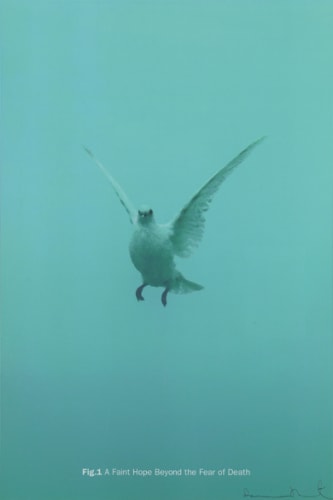Paul Stolper gallery is pleased to announce Damien Hirst's first solo presentation in Greece at The Macedonian Museum of Contemporary Art in Thessaloniki. Offering the general public the opportunity of coming into contact with the work of the most famous of the generation of British artists, which came to prominence in the early 1990s and became known as Young British Artists or YBAs.
Damien Hirst is one of a rare number of artists whose careers can be seen as both a "phenomenon" of individual success and symbolic of a whole era. His exhibition entitled "New Religion", addresses themes which run throughout his artistic practice and gives us an insight into his way of working.
Throughout his career, from the early signature sculptures such as "A Thousand Years", 1990 (a vitrine containing a severed cow's head, maggots and flies), and "The Physical Impossibility of Death in the Mind of Someone Living", 1991 (a vitrine in which a shark is immersed in formaldehyde), to later works such as "For The Love of God", 2007 (a human skull covered in diamonds), Hirst has tackled the grand historical themes of art; life and death and the fragility of existence; and in doing so has made a body of work that is consistently provocative and shocking.
Hirst's work is characterised by the clarity of his images and the immediacy of his message. Completely free of guilt, through risk and boldness, he uses and manipulates the mechanisms of creation and the devices of contemporary art.
Hirst has said: "There are four important things in life: religion, love, art, and science" and "New Religion" highlights the conflict between two of these - science and religion.
"New Religion" comprises silkscreen prints, sculptures, constructions and paintings to complete a total installation, which references the atmosphere of a chapel. A cross studded with pharmaceuticals like precious jewels vindicating their significance for human life and prosperity; a silver heart pierced by needles and razor blades and wrapped in barbed wire; a carved marble pill standing in for the Eucharist; a silver child's skull; silkscreen prints ("The Stations of the Cross", "The Apostles", "The Wounds of Christ") and medical charts comprise a list of works which pose questions in relation to science, its role as a 'new religion', religion itself and art.
Making use of religious imagery, titles and associations, and denaturing them through art, in a cold and clinical environment, the artist bridges the theoretical gap between science and religion, rephrasing questions regarding the way the two are perceived. Detached from responses and renouncing their final value and meaning, Hirst triggers mechanisms of thoughts and questions which are raised by him and relate to the most basic insecurities and fears of human existence.
The exhibition has previously been shown at the Victoria & Albert Museum in London, the Palazzo Pesaro Papafava in Venice and the Rogaland Museum in Stavanger, Norway.
Damien Hirst - "New Religion" at the Macedonian Museum of Contemporary Art, Thessaloniki
Co-organised by:
Macedonian Museum of Contemporary Art, Thessaloniki, Greece (MMCA)
British Council
Paul Stolper Gallery, London, UK
Supported by:
Le Palace Hotel
Curated by: Artemis Potamianou
Artistic Organization: Christos Savvidis (MMCA)

